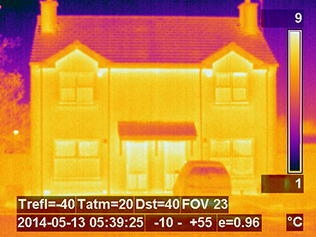Advanced Infrared Thermography for Building Inspections
Thermal Imaging, or Thermography, is a globally recognised and respected system for inspecting buildings for possible anomalies or problems within the building.
It can be used in any type of building or shelter, from traditional houses to apartment blocks, to commercial buildings.
Thermal Imaging first came to the fore in the oil crisis of the seventies when there was a lot of pressure to keep energy bills to a minimum, particularly in buildings. We can see a return to this way of thinking now with the spiralling cost of fuel and impending “peak oil” never far from anyones mind. There are many ways of investigating and surveying buildings other than Thermal Imaging, however relatively Thermal Imaging is vastly cheaper and provides the end user with a lot more useful information than older traditional what are now outdated systems. It is also completely non-destructive. It's an appropriate mantra that is used by anyone operating a camera but rings especially true for Thermographers - “the camera never lies". There are many reasons why owners/occupiers of buildings commission Thermal Imaging surveys.
By and large the most common reason is due to extraordinarily high heating bills or draughty buildings. Using Thermal Imaging, the trained Thermograper can detect missing/damaged/incorrectly placed insulation in walls/ceilings etc. If a building is placed in a vacuum state they can discover breaches in the insulated envelope, be it around doors, windows, services pipes etc., by identifying air passage or leaks around these areas (draught detection). The infrared cameras don’t actually see the cold air infiltration but rather the effect that the cold air infiltration has on the surfaces of the building's components. Another common use for Thermal Imaging in buildings is the tracking or chasing of water/moisture, be it in leaks in under floor heating loops or leaks in water pipes or water ingress in roofs. Yet another popular and useful use for Thermographic surveys in buildings is to identify areas of actual or potential mould growth, which can be detrimental to peoples' health; this in a way is linked inherently to tracking or chasing water.
Mould growth is not the problem, but rather is a symptom of the presence of moisture. Thermal Imaging of buildings is intrinsically complicated and should only be carried out by trained experienced Thermographers. With the advent of cheaper base models of Thermography cameras, a culture of point and and shoot inspections has evolved, which has led to poor surveys and poor, ill-informed advice, which ultimately leads to Thermal Imaging getting bad press. It is advisable whether renting or buying any kind of building to have a full thorough Thermal Imaging inspection carried out prior to any deal being signed. It gives potential owners a true and honest “Image” of what is or isn’t going on in their investment. Depending on what is found it can act as a powerful bargaining tool when trying to negotiate prices with vendors.


